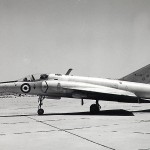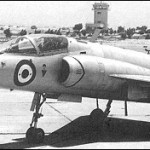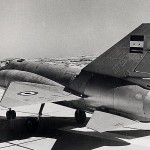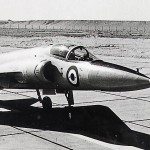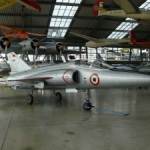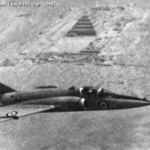
Willy Messerschmitt was no different, though his accomplishments after WWII paled in comparison to the sheer magnitude of what he was able to turn the Luftwaffe into during the war … albeit with the use of slave labor. With an encyclopedic take, it’s easy to write about Messerschmitt. Fact: His company built the airplanes that armed the Third Reich. Fact: His Bf 109 remains, to this day, the most-produced fighter plane in history at about 35,000 models built. Fact: His firm also produced the Me 262, the world’s first jet-propelled fighter.
But with a legacy like his, Messerschmitt can not be mentioned in journalistic work without the writer reminding the reader that he was also closely allied with the Nazi party, used slave labor, and spent two years in prison after a war crime tribunal convicted him of being a Nazi sympathizer.
As an aviation fan, there is also an obvious way to criticize Messerschmitt. He was a performance junkie. He sacrificed stability and safety for speed. That’s one thing about pushing the envelope: when you go where no one else has gone before, you have no way of knowing what’s there.
With that take on things, we look at his post-war work. Messerschmitt was banned from doing any German military work, including designing and manufacturing aircraft, until 1955. So he moved to Spain and joined Hispano Aviation. Francoist Spain was looking for a supersonic interceptor of domestic creation. His first project was an ultralight delta-shaped tailless fighter based on some of his war-era ideas. He didn’t get past the mock-up stage, and the plywood model he built was so unstable that that test flight could not be competed. This was the start of the HA-300.
The design had some merit. In 1959, Egypt bought the design and brought Messerschmitt in to develop the Helwan HA-300 for the Egyptian Air Force
The first prototype flew successfully in 1964 and achieved supersonic flight. With some concern about Egyptian-British relations, the program abandoned the British Orpheus Mk 703-S-10 turbojet in favor of a more powerful Egyptian E-300 engine. The engine was expected to push the HA-300 upwards of Mach 2.5, but it was never flown.
The HA-300 was looking like it was going to be a mass-produced success, but we’ll never know how it would have fared in combat. Following a major defeat in the Six-Day War, Egypt reallocated its military budget to replace army equipment and lost air defenses. The HA-300 was abandoned, but Egypt went on to purchase the similarly shaped MiG-21 “Fishbed.”
The HA-300 was also nowhere near a finished product when it was cancelled.
In the end, it’s highly possible that the HA-300 was just another late Messerschmitt crapshoot — all speed, no substance. It featured the same problems that early Messerschmitt jets, including the primal Me 262 faced — the airplane was essentially a rocket. There was little room for armament and no word on radar or computer/electronic equipment required in 60s-era jets. Egyptian MiG 21s were swatted out of the sky by Israeli Air Force pilots in a number of conflicts, and it stands to reason that a less advanced HA-300 would not have done much better.
The aircraft was also not tested for potentially disastrous inertial coupling and showed adverse bank with rudder use.
An article in the May 1964 edition of “Survival: Global Politics and Strategy” questions the then-in-development feasibility of the HA-300.
“The HA-300 is the type of aircraft in which space is at a premium, and it remains to be seen what type of armament and electronics will be fitted to it,” the article says.
Indian Air Force Group Captain Kapil Bhargava was a test pilot on the HA-300 project. In an article he published, Bhargava details an encounter he had with Egyptian President Gamal Abdul Nasser.
“I explained to President Nasser the layout and the most interesting features of the HA-300 and was asked my personal opinion of the Helwan fighter. In my reply, I endeavoured to imply that left to the foreign staff alone, the HA-300 would make an interesting research project but would never be developed into an effective weapon system. He just smiled. I concluded that, despite any difficulties that might hinder the project, he had his reasons for persisting with it and that too under the control of foreigners. He obviously believed that a successful flight test would be sufficient to strengthen his hand in international negotiations.”
Bhargava refused to fly the HA-300 unless the design team made several safety changes. Among other things, he said the aircraft pitched violently on the runway during taxiing. He also noted problems with fuel system, engines, and rudder.
“I told [the Egyptian Air Chief] that the aircraft was a death trap and I was not willing to fly it,” Bhargava wrote.
In response, Messerschmitt called Bhargava a chicken.
“My response was that I was not just chicken. I was [expletive] scared. I said I would be very dead, if I tried to fly the aircraft until its deficiencies were removed,” he countered.
The HA-300 was Messerschmitt’s last aircraft design. Germany acquired the first HA-300 prototype in 1991 and restored it. It is now on permanent display at the Deutsches Museum in Munich.
Specifications
General
Crew: One
Length: 40 ft 8 in
Wingspan: 19 ft 2 in
Height: 10 ft 4 in
Empty weight: 4,630 lb
Engine: One Bristol Orpheus 703 and later One Brandner E-300 turbojet
Performance
Maximum speed: Mach 1.13 with Bristol engine. Projected Mach 2.1-2.5 with Brandner E-300 engine
Range: 870 mi
Ceiling: 40,000 ft
Armament
Guns: Two 30mm Hispano or four 23mm Nudelman-Rikhter NR-23 cannon
Missiles: Planned for up to four IR air-to-air missiles
Essential Reading
Online Resources:
- Wikipedia
- Messerschmitt’s HA-300 And Its Indian Connection — Article by Retired Indian Air Force Group Captain Kapil Bhargava, who flew the HA-300
- Deutsches Museum
- Prime Portal — Great photo walk-through of the HA-300
- An Emirati’s Thoughts — Good discussion of Arab air force engagements and the feasibility of the HA-300
